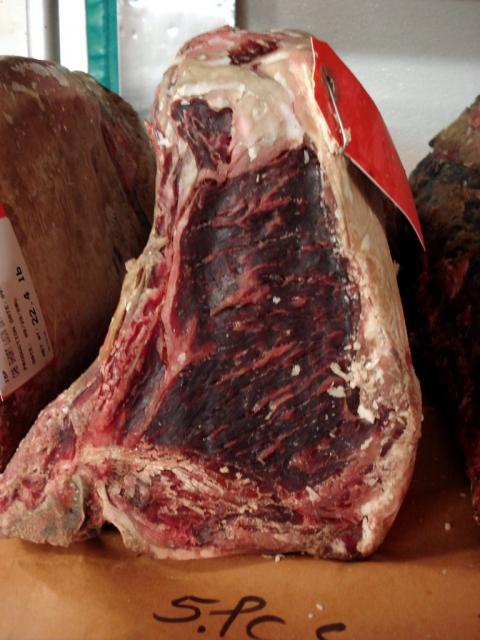
Photo by Flickr user Gary Grogan
By Paul LukasOne question people often ask about Fleisher's beef -- and about beef in general -- is, "Is it aged?"
Much like beef grading, which we discussed last week, aging is a term that tends to intrigue people, even if they don't fully understand what it means. We'll provide a basic explanation of it here.
First, it's important to understand that beef can actually be too fresh. You wouldn't want to eat beef the same day it had been slaughtered. It would be, quite literally, a bloody mess. It would also be extremely tough (the carcass must pass through the rigor mortis stage).
So all beef is aged to some degree. Most of it is wet-aged, which means it has been sealed in a Cryovac bag -- usually for a week or two, sometimes longer. This helps break down the meat's connective tissue, making it more tender, although it does nothing much for the meat's flavor. Meanwhile, some of the blood drains from the meat, so the beef is literally sitting in a pool of its own bodily fluids. This liquid is called purge, because it will be discarded when the Cryovac bag is eventually opened. This is how virtually all supermarket beef is processed, and most conventional restaurant beef as well.
Then there's dry-aging, which involves storing the meat under precise climate-controlled conditions. The aging chamber can be as large as a sizable room or as small as a wall-mounted refrigerator case, but the key is that the meat is maintained under precise climate-controlled conditions -- low temperature, relatively high humidity, and fans to provide lots of air circulation. Much like wet-aging, dry-aging provides time for the meat's connective tissue to break down and tenderize. In addition, the exterior of the meat becomes covered with a light coating of mold and forms a tough, dark outer crust that will eventually be cut away (some packing or processing houses call this the scab).

Photo by Flickr user DeBragga
Inside, however, some of the beef's moisture is evaporating, which concentrates the meat's flavor in a way that people have variously described as earthy, musky, mineral-y, funky, or just beefy. It's a much more complex flavor than what you get with wet-aging -- all the more so if you start with the pastured beef Fleisher's sells, because pastured beef is always more flavorful to start with.
Our beef carcasses typically hang for a week at our slaughterhouse before being broken down into the primal sections -- the chuck, the rib, the loin, and the round -- from which we will eventually cut steaks, roasts, and so on. Then the primals are dry-aged at our shop for up to four weeks, depending on the cut. Our rib-eyes, New York strips, and sirloins get the longest time in our coolers, and both the taste and the price reflect their extended stay.
Dry-aging is expensive, because there can be significant loss of product during the aging process. Between the evaporation and the cutting away of the outer crust, beef can lose up to 25% of its weight by the time it's done aging and ready to sell. But once you taste one of our dry-aged steaks, you'll know it's worth it.
 Aging: Wet vs. Dry
Aging: Wet vs. Dry
Great stuff here Paul. You need a link to the butcher shop from the blog though.
ReplyDeleteThanks. Now added.
ReplyDeleteIt's actually not the connective tissue of meat that breaks down during the post-mortem aging process increasing tenderness. It is the degradation of the contractile proteins (the ones that allow muscles to move) which contribute to the increased tenderness with all kinds of post-mortem aging--wet or dry.
ReplyDelete